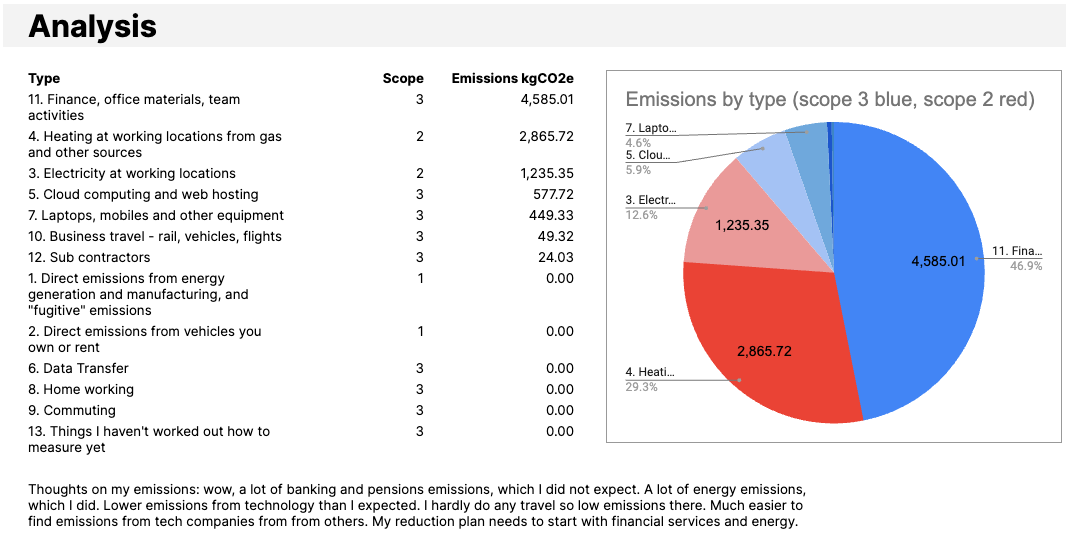9.79 tonnes CO2e per year
17 May 2024, updated 25 October 2024.
My company’s total carbon emissions are 9.79 tonnes CO2e per year, for the year 1 March 2023 - 29 February 2024.
 Holdfast Projects' carbon emissions 2023-2024
Holdfast Projects' carbon emissions 2023-2024
I offset 300% of those emissions in UK and international projects accredited by the UK Woodland Carbon Code or the Peatland Code and VCS respectively. There’s more detail below.
Carbon intensity: 0.043 tonnes CO2e per day
If your organisation buys time from me, you can use these numbers in your own Scope 3 emission calculations:
- 1 day: 0.043 tonnes CO2e.
- 1 week: 0.214 tonnes CO2e.
- 1 month: 0.816 tonnes CO2e.
These numbers use my emissions data for the year 1 March 2023 - 29 February 2024 - I divided total emissions by 229 working days per year.
However I am disclosing a smaller emissions factor of 2.67024 kgCO2e/day in my invoices to clients. Why? I choose to measure carbon emissions more widely (eg my financial services) and aggressively than is required by the GHG Protocol, so it seems fairer to disclose an official Gov.uk number. (More on this here.)
The next question is how I can reduce my emissions.
What I’m doing next to reduce emissions
- 15 July 2024: I will present my carbon emissions calculations in the same way that the GHG Protocol does (scope 3 categories etc) so it’s clearer. This may have the effect of reducing my apparent emissions since the Protocol requires only financial services companies to record financed emissions. But since those emissions feel real to me, I might end up disclosing emissions with and without financed emissions.
- 15 July 2024: I am exploring the viability of a tool to help freelancers in the digital industry quickly calculate their carbon emissions. This won’t reduce my emissions, but it might help you reduce yours.
- 13 June 2024: I will switch company pension to funds with lower carbon emissions. To do this I’m going to try find some ETFs that look a fair bit like a low cost global index tracker but have the lowest possible emissions. There’s going to be a tradeoff between these two aims. Funds don’t consistently publish emissions data, so this work might take a while.
Action I’ve already taken
- October 2024: added note about disclosing a different emissions factor in invoices to clients.
- September 2024: my work proposals now include an estimate of the carbon emissions, and my invoices now include the actual emissions. These numbers can be used in a client’s scope 3 emission measurements.
- 13 June 2024, updated 16 July: Joined a wind farm co-op, Ripple Energy. Ripple says the carbon saving is 0.14t in the first 6 weeks, but I’m not confident in calling this an emissions reduction because I’m still consuming electricity from the grid. However, supporting the deployment of renewable energy feels useful, and like a stepping stone to more action on my energy consumption that could directly reduce emissions, like PV panels or batteries.
- 17 May 2024: Switched bank to one with lower carbon emissions. This will reduce my emissions from banking by 68% from 0.57815 tCO2e to 0.18324 tCO2e, if the amount in the bank account were to remain the same.
- 8 May 2024: Offsetted the 300% emissions I calculated for 2023-4. Why 300%? To cover errors and omissions in my measurement and some of my historic emissions. Through Forest Carbon I bought 15 tCO2e offsets in VCS-accredited international projects that are already generating carbon credits, and 15 tCO2e in UK Woodland Carbon Code or the Peatland Code accredited projects in the UK that will create carbon credits in future. I like peat restoration projects because they’re long-term and have biodiversity and community benefits. The projects: reforestation in Uruguay and peatland restoration on Islay. Offsetting is a poor answer to decarbonisation because the emissions are still there, but it feels like a good way to start and build some momentum.
- 4 April 2024: Measured emissions for the year 1 March 2023 - 29 February 2024.
Related
- Switching bank account to reduce company carbon emissions
- Climate change is an engineering challenge
- Dirty internet: carbon aware websites
- Carbon transformation
For more like this:
climate transformation email newsletter:

